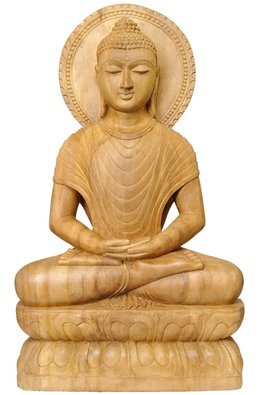A Discourse on Paticcasamuppada
by Venerable Mahasi Sayadaw | 62,614 words
The Paticcasamuppada refers to “The Doctrine of Dependent Origination”. This is the English translation done by U Aye Maung Published by U Min Swe Buddhasasana Nuggaha Organization Rangoon, Burma....
Chapter 4 - Six Kinds Of Tanha
Tanha is never tired of seeing pleasant objects, man or woman whom it likes. It seeks sweet sounds. It hungers for good scent, good food and good drinks. It craves for tactile sensation and this is surely the worst craving for people who love sensual pleasure. Tanha also means liking for mind objects that are impervious to the eye, the ear and other physical organs. It is the object that we can know only mentally. According to the scriptures it means the five sensitive (pasada) rupas, the four subtle elements such as apo, etc., the mental elements (cetasikas) concepts of forms, qualities, names, etc.
People crave for good pasada rupas because they want to see clearly, to hear distinctly, or to have keen sense of touch. They seek apo elements as they wish to keep their mouth, throat and skin moist. They delight in the consciousness of their own sex and the opposite and hence their craving for manhood and womanhood. They want to live long and to move lightly, and this desire shows their hunger for the fine rupas of jivita and kayalahuta, etc. Their desire for happiness, good memory and good intelligence points to their craving for certain mental faculties. Love of ones own physical appearance and that of the opposite sex as well as the desire for praise and fame again shows the hunger for concepts.
For six sense objects there are six kinds of craving. These six cravings may mean merely the love of sensual pleasure (kamatanha). This love may be combined with the illusion of permanence (bhavatanha), tanha that implies the eternity belief. Craving is also bound up with the belief in annihilation which makes some people overly attached to sensual pleasure (vibhavatanha). So there are six cravings (corresponding to six sense objects) for each of the three tanhas (kamatanha, bhavatanha and vibhavatanha) or 18 cravings. Each of these cravings may have internal objects or external objects and this leads to 36 kinds of craving. Since each craving may relate to the present, past or future, there are thus a total of 108 kinds of tanha. But all kinds of craving boil down to three kinds of tanha viz., kama-, bhava- and vibhava tanhas.
People who are in contact with unpleasant sense objects long for pleasant objects. Those who suffer pain seek freedom from it. In short, according to the commentary, the suffering person longs for happiness. People seek freedom from pain, poverty and unpleasant objects and feelings. Absence of suffering means happiness (sukha). We seek freedom from preoccupation with unpleasant thoughts, from worry about food, clothing and shelter. But, once a man is well provided with the necessities of life, he tends to develop other cravings. Says the commentary, “The wealthy man wants to increase his wealth.” For it is in the nature of tanha to be insatiable. We wish to enjoy the good things of life repeatedly; we wish to increase our possessions. The more we have, the more we want, and the higher the quality of life is, the greater is the desire to enhance it. Tanha never comes to an end for it is fuelled and perpetuated by vedana or feeling.
As regards the tanha associated with upekkha (neutral) feeling, the commentary describes the concomitant feeling as pleasant (sukha) because of its poise and subtlety. In the case of our contact with ordinary sense objects, neither the pleasant feeling nor unpleasant feeling is apparent; but since this upekkha feeling is fine and subtle, it is tinged with (sukha) pleasantness and hence it makes us crave for more definite pleasure. It leads to discontentment with the ordinary sense objects and kindles the desire for better food, better clothes, better sense contact and better living conditions.
In short, pleasant sense objects create attachment and craving for better objects. Unpleasant objects create the desire to be rid of them. When the sense objects produce neither pleasant nor unpleasant feelings, we are still discontented with our lot and crave for better things. All these show how vedana gives rise to tanha.
